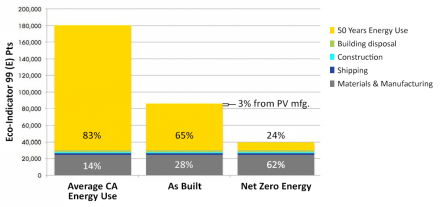You are here
Climate change is happening and its effects will have severe consequences for our society and environment. Reducing energy use in buildings is one of the most important ways to reduce humans’ overall environmental impact.
 |
| Ice core records from Antarctica show that changes in carbon dioxide concentrations (blue) track closely with changes in temperature (red). Carbon dioxide levels are now higher than at any time during the past 650,000 years. (CREDIT: Marian Koshland Science Museum, source) |
Nearly unanimous scientific consensus has established that climate change is occurring as a result of human activity. Mathematical models of global climate change have linked a human-driven increase in Greenhouse Gas Emissions (GHGs) to an increase in global temperatures (especially in the past 250 years, since the industrial revolution). The primary source of this increase in GHGs has been attributed to the emissions generated by the use of fossil fuel-based energy.
Climate change has been linked to observable disturbances such as the loss of mountain glaciers and ice cover on the Earth’s polar regions, changes in the timing of the spring bud-break, and an increase in the frequency and intensity of extreme weather events such as cold waves, heat waves, large storms, hurricanes and tornadoes, floods, and droughts.
Climate scientists have theorized that human civilization is in danger of crossing a threshold or “tipping point” that could lead to more radical changes in the global climate, and that could accelerate the onset of either a new “hotter and wetter” age similar to the Earth’s environment before the appearance of human beings, or a new ice age. (Intergovernmental Panel on Climate Change, IPCC Fifth Assessment Report [AR5]).
Scientific estimates place the window of opportunity for reversing this trend in the very near term—according to some, as briefly as over the next ten years. After that, the global climate may change irreversibly, and humans will just have to adapt.
In many arenas of implementing real practical change, architects, engineers, and builders are amongst the few with the skills and resources that provide real, practical, cost-effective, and inspiring solutions for buildings.
Environmental Impacts of Buildings
| Quick stats |
|
Buildings account for 40% of energy use worldwide (WBCSD). Energy used during its lifetime causes as much as 90% of environmental impacts from buildings (Journal of Green Building). Building operations consume more than 2/3 of all electricity (BuildingScience.com) Residential and commercial buildings consume 40% of the primary energy and 71% of the total electricity in the United States. |
Buildings account for 40% of worldwide energy use — which is much more than transportation. Furthermore, over the next 25 years, CO2 emissions from buildings are projected to grow faster than any other sector (in the USA), with emissions from commercial buildings projected to grow the fastest—1.8% a year through 2030 (USGBC).
Often, energy use in the form of electricity drives the largest environmental impacts. Where that electricity comes from determines what those impacts are. In the United States for example, where buildings account for more than 70% of electricity use, most of the electricity is generated by coal-fired electrical power plants (USGBC). Generating one megawatt hour (MWh) of electricity in the US produces approximately 250 – 900 kg of CO2 depending on the mix of coal, nuclear, hydro and other sources of fuel (US EPA). As a reference, the average US household consumes approximately 11 MWh of electricity per year (US EIA).
These exact impacts can be quantified by lifecycle assessment (LCA), the most thorough way to determine the environmental impacts of a design. There is no perfect way to measure environmental impact. LCAs can measure greenhouse gas (units = CO2e = CO2 equivalent) to measure global warming potential, or might measure other things like human health, water, and land-use impacts. You may hear the word “embodied energy” or “embodied carbon” – this refers to the energy or greenhouse gas emissions caused throughout an object’s lifecycle. Alternatively, sometimes an overall normalized score is used to combine many kinds of impacts into a single number (i.e. Eco-Indicator 99). A good primer on LCA is here.
A 2012 LCA study found that “Specifically within commercial buildings, the use and operation phase of the material and building life cycle is so dominant that the impacts of construction, demolition/disposal, and transportation are nearly irrelevant for most traditionally constructed buildings.” (Journal of Green Building)
|
Total life cycle impacts by life cycle phase for a prefabricated commercial building with average California energy use, the building as built (30% of power supplied by photovoltaics), and net zero energy (100% of power supplied by photovoltaics), in units of EcoIndicator99 points. |
“Lifetime energy use energy dominates traditional and even energy-efficient building life cycles, by far. In such cases, other environmental concerns are nearly always trumped by energy performance. Once a building meets all energy needs by clean power generation (whether it be on-site PV panels, PV grid power, or other equally clean renewables not analyzed in this study), then building materials and manufacturing becomes the dominant life cycle impact phase.” (Journal of Green Building) |
Since 1920, the overall trend in building energy use for commercial buildings is higher energy intensity per square foot (BuildingScience.com). It is important to reverse this trend.
In the coming decades, rapid development will continue in the developing countries, while many buildings in the developed world will need to be renovated and retrofit. We need to make sure that the engineers and architects working on these buildings are equipped to make design choices that use energy effectively.
Links and References
- This non-profit is focused on climate change advocacy and education. This is their page on the science of climate change.

